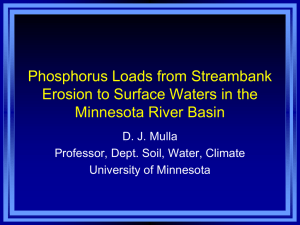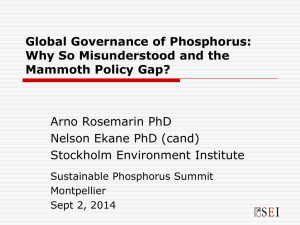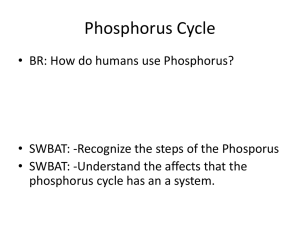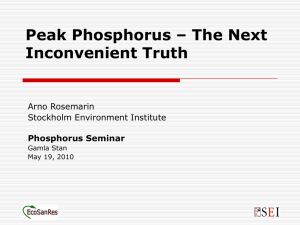Characterizing Flow and Phosphorus Loads for Lake Okeechobee
advertisement
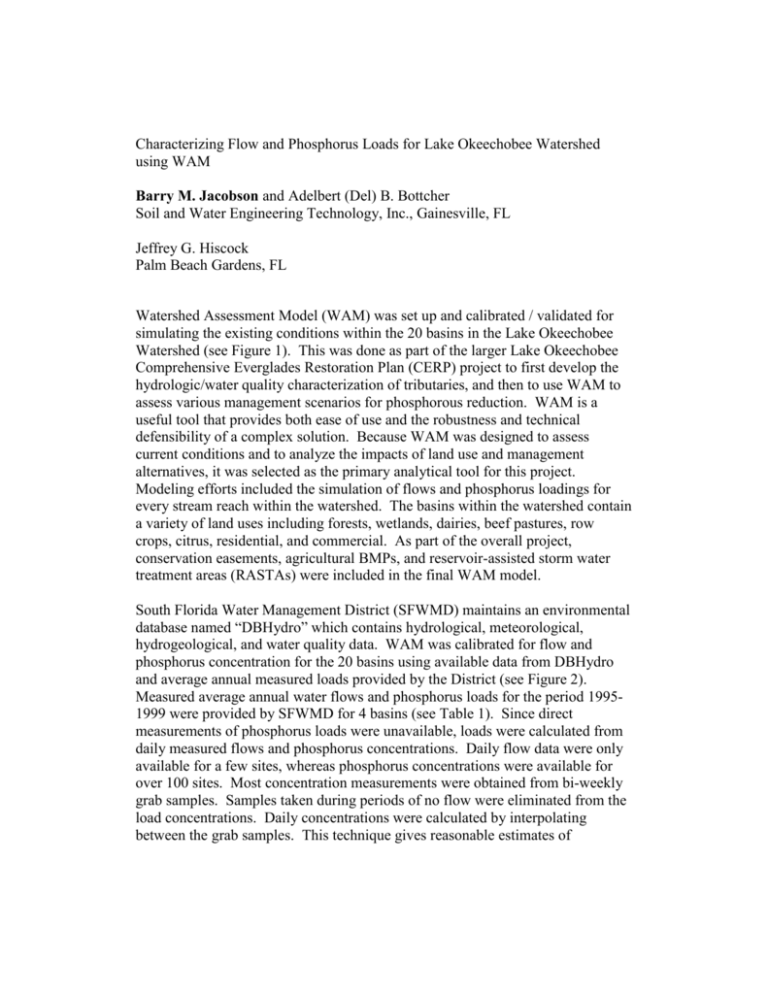
Characterizing Flow and Phosphorus Loads for Lake Okeechobee Watershed using WAM Barry M. Jacobson and Adelbert (Del) B. Bottcher Soil and Water Engineering Technology, Inc., Gainesville, FL Jeffrey G. Hiscock Palm Beach Gardens, FL Watershed Assessment Model (WAM) was set up and calibrated / validated for simulating the existing conditions within the 20 basins in the Lake Okeechobee Watershed (see Figure 1). This was done as part of the larger Lake Okeechobee Comprehensive Everglades Restoration Plan (CERP) project to first develop the hydrologic/water quality characterization of tributaries, and then to use WAM to assess various management scenarios for phosphorous reduction. WAM is a useful tool that provides both ease of use and the robustness and technical defensibility of a complex solution. Because WAM was designed to assess current conditions and to analyze the impacts of land use and management alternatives, it was selected as the primary analytical tool for this project. Modeling efforts included the simulation of flows and phosphorus loadings for every stream reach within the watershed. The basins within the watershed contain a variety of land uses including forests, wetlands, dairies, beef pastures, row crops, citrus, residential, and commercial. As part of the overall project, conservation easements, agricultural BMPs, and reservoir-assisted storm water treatment areas (RASTAs) were included in the final WAM model. South Florida Water Management District (SFWMD) maintains an environmental database named “DBHydro” which contains hydrological, meteorological, hydrogeological, and water quality data. WAM was calibrated for flow and phosphorus concentration for the 20 basins using available data from DBHydro and average annual measured loads provided by the District (see Figure 2). Measured average annual water flows and phosphorus loads for the period 19951999 were provided by SFWMD for 4 basins (see Table 1). Since direct measurements of phosphorus loads were unavailable, loads were calculated from daily measured flows and phosphorus concentrations. Daily flow data were only available for a few sites, whereas phosphorus concentrations were available for over 100 sites. Most concentration measurements were obtained from bi-weekly grab samples. Samples taken during periods of no flow were eliminated from the load concentrations. Daily concentrations were calculated by interpolating between the grab samples. This technique gives reasonable estimates of phosphorus loads; however, the errors associated with this technique are expected to range between 25 and 50% of actual loads. Since WAM is a process-based model, traditional model calibration was not utilized. However, all possible field parameters which can be physically measured to ensure accurate model rendering of the basin were considered. For example, locations of culverts and other flow control structures were determined and accurately reflected in the simulated physical representation. Also, site visits and stage data were used to improve stream profile definitions. Stage, flow, and phosphorus data were gathered and quality checked for use in model verification. Daily stages, flows, and phosphorus loads were simulated for each stream reach in each basin for the period 1991 through 2000. Based on visual comparisons of simulated and measured phosphorus concentration levels, responses to rainfall events, and the accuracy of the measured data, the simulated values matched the measured values quite well. The comparisons of measured and simulated values indicate that WAM can reliably simulate flows and phosphorus loads and concentrations discharged from the basins. Since many subbasins and basins have little or no measured data, these simulations are the best estimates of current flows and loads available. WAM’s demonstrated ability to simulate the impacts of land use and management makes it a powerful tool in assisting planners and decision makers to develop strategies to maintain and improve water quality. Table 1. Measured and Simulated Phosphorus Loads and Concentrations Basin S-191 S-154 C-41 Fisheating Creek Source Measured Phosphorus Phosphorus Discharge Concentration Load (acre-feet) (ppb) (tonnes) 113,467 653 91.2 Simulated 119,237 617 90.2 Measured 31,885 828 32.5 Simulated 30,867 540 20.8 Measured 52,630 433 28.0 Simulated 76,718 286 27.1 Measured 249,378 176 54.1 Simulated 265,654 197 64.5 Figure 1. Project Basin Locator Map 4 Simulated -- Reach 62 Measured -- Station TCNS213 Jan-94 Jan-97 3.5 Total Phosphorus (ppm) 3 2.5 2 1.5 1 0.5 0 Jan-91 Jan-92 Jan-93 Jan-95 Jan-96 Jan-98 Jan-99 Jan-00 Figure 2. Total Phosphorus Concentration for Basin S-191 Station TCNS213 Jan-01 Barry M. Jacobson, PhD, PE Vice-President Soil & Water Engineering Technology, Inc. 3448 NW 12th Ave. Gainesville, FL 32605 352-378-7372 352-378-7472 (fax) jacobson@swet.com


